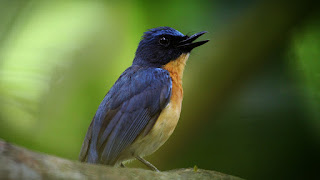Lies around Sahyadri ranges are the great Western Ghats
separated through a steep plain from the Deccan plateau. This mesmerizing green valley has thousands
of wildlife species, including over 325 globally endangered ones.
The Western Ghats have around 139 species of reptiles,
mammals, and amphibians (including the rare purple frog), 102 fish species,
annelids, mollusks, 508 species of birds (including the most anticipated
Malabar parakeet and Malabar grey hornbill) and over 6000 insect species.
The hills and national parks of Western Ghats are the major
corridors for wildlife, including Indian elephants, big Indian cats, rare Gaur
(Indian Bison), wild boars, and the rare sloth bears. Along with the wild
species listed here, you can also find the unique species of India in the
Western Ghats like Indian giant squirrel, Indian flying fox, and Nilgiri goat.
These reasons are enough to make Western Ghats listed as UNESCO World Heritage
Site in India.
Bird Species
The Western Ghats are the most bio-diverse hotspot in the
world with over 508 bird species in the Nilgiri biosphere reserve. Some of the
endemic birds in the Western Ghats are Nilgiri wood pigeon, Malabar parakeets,
grey-headed bulbul, Malabar grey hornbill, Nilgiri flycatchers, and various flying
predators. Malabar parakeets are some of the most beautiful endemic bird
species in Palani hills.
Mammal Species
The Western Ghats also houses thousands of beautiful and
rare mammals, such as Black Panther (the big cats of India), the Royal Bengal
Tiger and leopards. The Malabar large-spotted civet and lion-tailed macaque are
some of the endangered mammals of Western Ghats. A lot of endemic mammal
species in the Western Ghats are so rare that they are not spotted anywhere in
the world. Huge numbers of Asian elephants call the biosphere of Nilgiri
Mountains their home. Nilgiri Tahr and Nilgiri Marten are some of the rarest
animals in the Western Ghats.
Reptile Species
You can find a great diversity of reptiles in the Western
Ghats, including Vipers, one of the world’s most dangerous snake species. It
has over 13 reptile species, including the dwarf gecko, the giant monitor
lizard, and Malabar flying lizard. King Cobra, the most poisonous and deadly
snake species, is found in the Western Ghats.
King Cobra preys and inhabits the dense forests of Kerala
and rainforests of Western Ghats. You can also spot other exotic and venomous
reptiles and dangerous crocodiles in the Western Ghats.
Amphibian Species
The rich population of amphibians lives in the Western
Ghats. Out of 179 amphibian species, over 80% of these are endemic ones,
including the near-extinct purple frog and Malabar flying frog. Also called a
pig nose frog, the purple frog also serves as a living fossil to the forest.
Email Id: info@asianadventures.in
M: +91 8010450000
Don’t miss joining our ‘conservation-travel’ community! Click Here





No comments:
Post a Comment